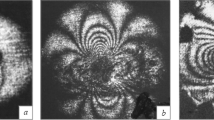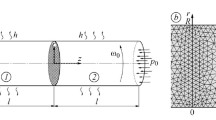Conclusions
-
1.
The selection of the optimum parameters of local heating with gas torches makes it possible to induce compressive residual stresses of ≈0.5σT in the plates. To obtain the maximum possible magnitude of the compressive residual stresses, it is sufficient to heat the regions to comparatively low temperatures (400–500°C).
-
2.
The maximum possible magnitude of the compressive residual stresses in axisymmetric heating of infinite plate does not exceed 0.6 of the yield stress of the given material.
-
3.
The effect of external loading changes the fields of the residual stresses induced by local heating. In the range of external loads typical of fatigue of welded joints, the reduction of the maximum compressive residual stresses does not exceed 30% of their initial value.
Similar content being viewed by others
Literature Cited
V. I. Trufyakov, Fatigue of Welded Joints [in Russian], Naukova Dumka, Kiev (1973).
Yu. F. Kudryavtsev and N. B. Naumchenkov, Fatigue of Welded Structures [in Russian], Mashinostroenie, Moscow (1976).
V. I. Trufyakov, V. V. Knysh, P. P. Mikheev, and A. Z. Kuz'menko, “Analytical description of the relationships governing fatigue crack propagation taking into account the residual welding stresses,” Avtom. Svarka, No. 6, 1–4 (1983).
O. Puchner, “Effect of internal stresses induced in the material on the fatigue limit,” Czech. Heavy Ind., No. 1, 4–11 (1961).
N. A. Klykov, “Using concentrated (spot) heating for increasing the fatigue strength of welded joints,” Avtom. Svarka, No. 8, 33–37 (1966).
T. Fujimoto, “Fundamental theory of elastoplastic thermal stresses due to welding based on the inherent strain method,” J. Jpn. Weld. Soc.,45, No. 1, 14–21 (1976).
M. A. Ol'shanskii (ed.), Welding in Engineering (A Handbook in Four Volumes) [in Russian], Vol. 1, Mashinostroenie, Moscow (1978).
Ya. S. Uflyand, Integral Transformations in Problems of the Theory of Elasticity [in Russian], Nauka, Leningrad (1967).
V. N. Maksimovich, “Optimum distribution of residual plastic strains in local hardening of thin-wall structures,” Fiz. Khim. Mekh. Mater., No. 1, 85–90 (1983).
A. N. Guz', F. G. Makhort, and O. I. Gushcha, An Introduction into Acoustoelasticity [in Russian], Naukova Dumka, Kiev (1977).
V. I. Trufyakov, O. I. Gushcha, and Yu. F. Kudryavtsev, Alternation of Residual Stresses in Welded Joints at Cyclic Loading, Int. Inst. Weld. Doc. XIII-1031-81.
Additional information
E. O. Paton Welding Institute, Academy of Sciences of the Ukrainian SSR, Kiev. Translated from Problemy Prochnosti, No. 4, pp. 32–36, April, 1985.
Rights and permissions
About this article
Cite this article
Maksimovich, V.N., Chabanenko, A.A., Mikheev, P.P. et al. Determination of the parameters of local heating for increasing the fatigue resistance of welded joints. Strength Mater 17, 479–483 (1985). https://doi.org/10.1007/BF01533945
Received:
Issue Date:
DOI: https://doi.org/10.1007/BF01533945




